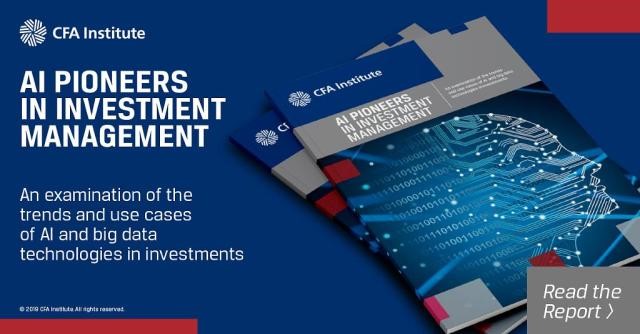
What can AI and big data do for finance?

Larry Cao, CFA, is the author of AI Pioneers in Investment Management from CFA Institute.
AlphaGo brought artificial intelligence (AI) out of computer labs and into the living room.
From October 2015, when the AlphaGo AI first beat a professional human competitor, to January 2018, several months after it defeated Ke Jie, the top-ranked player in the world, AI’s popularity had tripled as measured by Google Trends.
Investment professionals have watched all this from the sidelines with a mixture of excitement and anxiety: Will AI beat humans in investing too?
The AI Pioneers in Investment Management report from CFA Institute addresses this issue in detail by examining the trends and use cases of AI and big data in investments around the world.
Let me break down some of the report’s major revelations.

What can AI and big data do?
AI and big data are enabling technologies. Together they help us accomplish two things:
- Process new data that we did not have access to or couldn’t process before.
- Process data in ways that we weren’t able to before.
Thanks to advances in natural language processing (NLP), computer vision, and voice recognition, we can now sort and analyse more and more text, imagery, and spoken language through automation. AI programmes in these areas have already outperformed the average human.
So what can we extrapolate from these developments? That many repetitive and rudimentary tasks — transcription, for example — will increasingly be handled by AI programs.
Big data’s popularity is very much a function of these advances and their expected evolution. AI programmes target what’s called unstructured data — social media postings, depersonalised credit card transactions, and satellite imagery, for example — that mainstream analysts rarely used before. This new, alternative data forms much of the new frontier in investment management.
By harnessing advances in machine learning and deep learning, we can find new and more accurate relationships from this data. Much of today’s data analysis still relies on linear programming techniques that place constraints on the variables and their assumed relationships. Machine learning and deep learning have the potential to remove these barriers in many cases.
What can AI and big data do in investing?
AI and big data represent the future of investing. Their broad application is likely to usher in perhaps the most significant change in the history of the industry. Why? Because with AI and big data:
- Analysts will be able to perform more thorough analysis.
- Portfolio managers will make better informed decisions.
We now not only have access to more and different varieties of information, but also more timely — even real-time — information. We can apply satellite data and look under many unturned rocks much more quickly.
For example, in the old days, if we wanted to independently verify a store’s performance, we might sit in the parking lot and monitor car and foot traffic. But big data gives us efficient ways to maximize first hand data. Rather than staking out car parks, we can buy satellite imagery of lots of store parking lots — indeed, as many as we can afford.
While Tesla’s production information may not be available until its official release, we can estimate staffing levels based on publicly available cell phone data. In fact, that’s precisely what Thasos Group did. By gauging the number of cell phones present near Tesla’s plant, they independently verified that Tesla was running around the clock with three full shifts.
Add machine learning and deep learning to big data, and we can now crunch the data in countless new ways. This has vastly expanded the applications of traditional quant methods. We can feed the model input, and the model gives us an output.
Of course, we need to set the parameters properly, but the process makes it possible to capture relationships that might previously have been unknowable. On the downside, there can be a problematic black box effect: The analysis may not yield a true window into the relationships between the input and the output.
How should investment professionals respond?
Having read all that, should we now go freshen up our computer programming skills?
It would be commendable. But we’re probably better off prioritizing two things:
- Taking our investment skills up a notch.
- Developing a sufficiently broad knowledge base to work well with colleagues/collaborators in technology.
Why? Because the successful investment professionals and teams of the future will be strong in both artificial intelligence and human intelligence. These teams will have both an investment and technology function as well as an innovation function.
The world is getting increasingly complex and specialised. The days of multi-talented operators who do everything on their own are largely over. The expectation for future investment professionals is that they will need T-shaped skills — specialised investment knowledge along with enough technology and “soft” skills to work with the data scientists on their teams. Tech professionals on the investment team will also need to know about investing.
The main takeaway is clear: AI will transform investment management, but it is not the mass extinction event for human investment managers that many fear. Rather, those investment teams that successfully adapt to the evolving landscape will persevere. Those that don’t will render themselves obsolete.
The future is here. And it is in our hands.
For more insights on artificial intelligence, check out AI Pioneers in Investment Management.
If you liked this post, don’t forget to subscribe to the Enterprising Investor.
